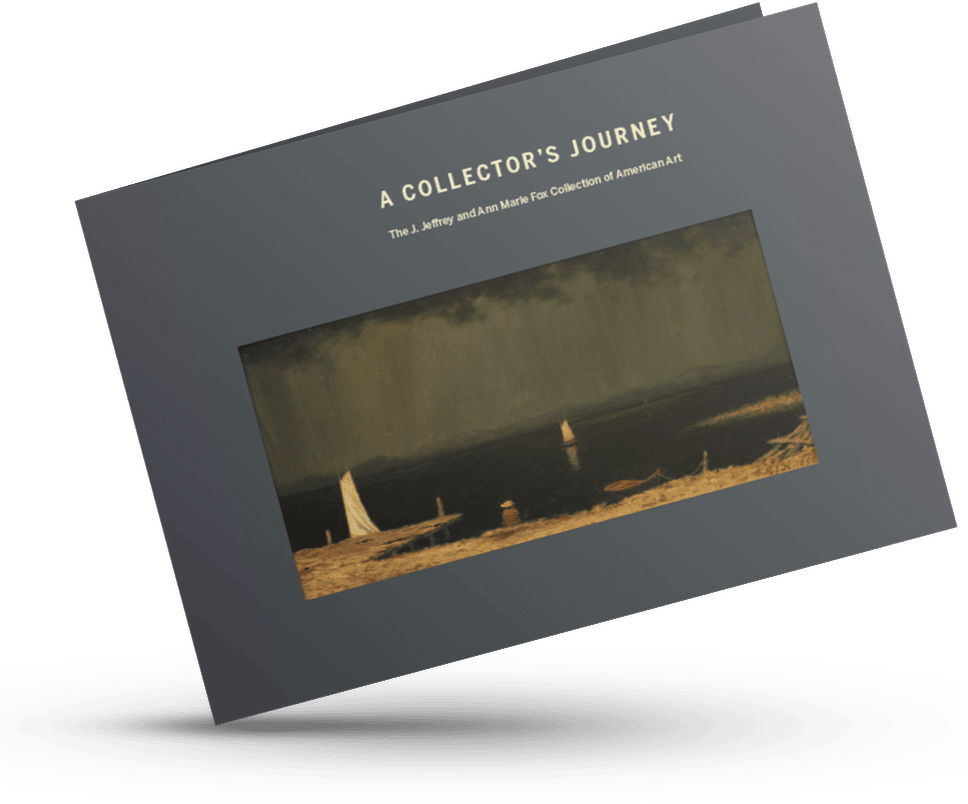Jasper Francis Cropsey (1823–1900)
Autumn in the Ramapo Valley, Erie Railway, 1873
-
Oil on canvas
-
38⅝ x 68⅛ inches - Framed: 57 ⅛ x 86 ⅝ inches
-
Signed and dated: J. F. Cropsey, 1873
Provenance
- The Artist
- James McHenry, London, United Kingdom, 1873
- Private collection, London, United Kingdom, from the 1950s
- Collection of J. Jeffrey and Ann Marie Fox Foundation for American Art
Exhibited
Office of Charles Day, 35 William Street, New York, New York, September 1873
Literature
“Art Notes.” New York Evening Post, July 21, 1873, 1.
“Our Artists: Where Have They Gone To? And Why Don’t They Go Somewhere Else?” New York Herald, July 30, 1871, 11.
“Art Etchings.” Indianapolis Sentinel, August 17, 1873, 2. (partial reprint of New York Evening Post, July 21, 1871)
“A New Painting.” New York Evening Post, September 19, 1873, 2.
“Art Matters.” New York Herald, September 20, 1873, 5.
“The Brush and Chisel.” Frank Leslie’s Illustrated Newspaper, October 11, 1873, 79. G. W. Sheldon, American Painters: With One Hundred and Four Examples of Their Work Engraved on Wood (New York: Benjamin Blom, 1972), 83.
“American Painters: Jasper F. Cropsey, Horace W. Robbins, and Wyatt Eaton.” Art Journal (New York: Brooklyn Museum, 1879), Vol.5, 78. (reprint of Sheldon’s American Painters)
Anthony M. Speiser, Jasper Francis Cropsey, Catalogue Raisonne: Works In Oil, Volume Two: 1864–1884 (New York: Newington Cropsey Foundation), 142–143, 351.
Note
Note: Painted during the summer of 1873 while Jasper F. Cropsey was staying in Warwick, New York, this work was commissioned by the English railroad magnate James McHenry to commemorate his out maneuvering Jay Gould to achieve control of the Erie Railway. The painting was shipped to London, United Kingdom in September of 1873 and remained in the United Kingdom for over 150 years. It was returned to the United States in December 2024 to become part of the collection of the J. Jeffrey and Ann Marie Fox Foundation for American Art.
Note II: The work depicts a vividly colored autumnal scene along the Erie Railway between Sloatsburg and Southfields, with the Ramapo River winding through a narrow valley and cascading in the foreground. Critics at the time praised the painting for its subtle atmospheric effect, rich gradation of color, and faithful transcription of natural detail. The New York Evening Post highlighted Cropsey’s success in capturing “the most brilliant of the ever-varying hues of autumn,” noting that “the gradation of color, from the strong and brilliantly varied tints in the foreground to the more subdued tones in the distance, is given with a freedom of manner and a knowledge of the relations of light and shade which is entitled to more than ordinary consideration.” The New York Herald similarly emphasized the thoughtful execution of the work, stating that “time and thought have been worthily bestowed” upon the canvas.
Note III: James Mc Henry was born in Ireland in 1817 and immigrated with his family to Philadelphia, Pennsylvania that same year. He grew up in Philadelphia and became a lawyer and successful merchant prior to moving to England. He became a very wealthy financier and raised financings to fund the growth of rail roads in the United States, including the Erie Railway. He was a patron of the arts and in addition to Autumn in the Ramapo Valley, Erie Railway, 1873, he owned other Jasper Cropsey paintings including: Richmond Hill in Summer, 1862, Wawayanda Valley, ca. 1862, and Albert Bierstadt’s master piece, The Rocky Mountains, Lander’s Peak, 1863 which McHenry purchased in 1865 for a record $25,000.
Related Work
Autumn on the Ramapo River–Erie Railway, 1876, oil on canvas, 37⅛ x 63⅛ inches; St. Johnsbury Athenaeum, Johnsbury, Vermont
Autumn Landscape, Sugar Loaf Mountain, Orange County, New York, oil on canvas, 28½ x 35½ inches; The Metropolitan Museum of Art, New York

catalogue
A Collector’s Journey
The catalogue, A Collector’s Journey, is designed specifically for museum directors and curators, by focusing solely on the appearance, provenance, and exhibition history of each painting. The collections are dynamic and will continue to expand as additional exceptional and historically important paintings are acquired.
contact us
Contact Us About The Collection
The foundation is committed to broadly sharing our collection with museums. If you are a museum director or curator interested in exhibiting works from the collection, please contact us.


